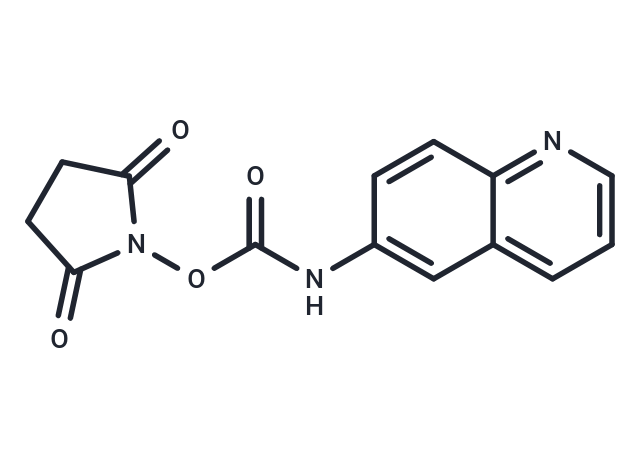Shopping Cart
Remove All Your shopping cart is currently empty
Your shopping cart is currently empty
AQC (6-Aminoquinolyl-N-hydroxysccinimidyl carbamate) is a reagent used in HPLC for the fluorescence detection of amino acid or protein sequences. It reacts with primary and secondary amino acids to produce fluorescent derivatives, enabling the detection of amino acids at picomolar levels.

| Pack Size | Price | USA Warehouse | Global Warehouse | Quantity |
|---|---|---|---|---|
| 10 mg | $42 | In Stock | In Stock | |
| 25 mg | $68 | In Stock | In Stock | |
| 50 mg | $113 | In Stock | In Stock | |
| 100 mg | $168 | In Stock | In Stock | |
| 500 mg | $422 | In Stock | In Stock | |
| 1 mL x 10 mM (in DMSO) | $35 | In Stock | In Stock |
| Description | AQC (6-Aminoquinolyl-N-hydroxysccinimidyl carbamate) is a reagent used in HPLC for the fluorescence detection of amino acid or protein sequences. It reacts with primary and secondary amino acids to produce fluorescent derivatives, enabling the detection of amino acids at picomolar levels. |
| In vitro | Instructions 1. Solvent selection: AQC is dissolved in an organic solvent, such as anhydrous dimethyl sulfoxide (DMSO) or acetonitrile, and a solution with a concentration of 1–10 mM is usually used. The concentration needs to be adjusted according to the experimental requirements before use. 2. Reaction steps: a. Mix the amino acid or protein sample to be detected with the AQC solution. b. The reaction is usually carried out in a buffer solution of about pH 8.0, the reaction temperature is generally room temperature, and the time is 10-30 minutes. c. After the reaction is completed, the sample can be used for high-performance liquid chromatography (HPLC) analysis. 3. Detection and analysis: AQC derivatives have specific fluorescent properties, with an excitation wavelength of usually 250-350 nm and an emission wavelength of 395-400 nm. HPLC can be used with a fluorescence detector for separation and quantitative analysis to detect the concentration and sequence information of amino acids or proteins. Notes: 1) AQC reagents may be sensitive to moisture, so they need to be stored in a dry environment. 2) It is necessary to ensure that the reaction conditions are properly controlled to avoid sample loss or side reactions. 3) The product after the reaction needs to be analyzed by HPLC to remove unreacted AQC. |
| Synonyms | 6-Aminoquinolyl-N-hydroxysccinimidyl carbamate |
| Molecular Weight | 285.25 |
| Formula | C14H11N3O4 |
| Cas No. | 148757-94-2 |
| Smiles | O=C(Nc1ccc2ncccc2c1)ON1C(=O)CCC1=O |
| Relative Density. | 1.48 g/cm3 (Predicted) |
| Storage | keep away from direct sunlight,store under nitrogen | Powder: -20°C for 3 years | In solvent: -80°C for 1 year | Shipping with blue ice/Shipping at ambient temperature. | |||||||||||||||||||||||||||||||||||
| Solubility Information | DMSO: 95 mg/mL (333.04 mM), Sonication is recommended. | |||||||||||||||||||||||||||||||||||
| In Vivo Formulation | 10% DMSO+40% PEG300+5% Tween-80+45% Saline: 3.3 mg/mL (11.57 mM), Sonication is recommeded. Please add the solvents sequentially, clarifying the solution as much as possible before adding the next one. Dissolve by heating and/or sonication if necessary. Working solution is recommended to be prepared and used immediately. The formulation provided above is for reference purposes only. In vivo formulations may vary and should be modified based on specific experimental conditions. | |||||||||||||||||||||||||||||||||||
Solution Preparation Table | ||||||||||||||||||||||||||||||||||||
DMSO
| ||||||||||||||||||||||||||||||||||||
| Size | Quantity | Unit Price | Amount | Operation |
|---|

Copyright © 2015-2026 TargetMol Chemicals Inc. All Rights Reserved.